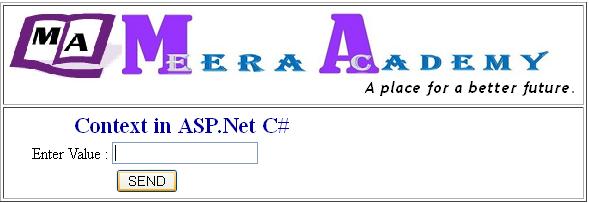The ASP.Net Context object is the same as the Session Object as we learnt previous asp.net post.
The Context Object is used to store the Value and Send it to the other page in ASP.Net.
The main Difference between Context and Session is the Context Object will be null when we send page to server.
That means we we use Context Object we must use Server.Transfer Method to redirect user to other page.
If we use Response.Redirect the Context value will be null on other page.
we can use Response.Redirect and Server.Transfer with Session Object in ASP.Net, but Response.Redirect cant use with Context Object in ASP.Net.
The Syntax of Context Object in ASP.Net
Declare the Context Object in ASP.Net
Context.Items[“Id”]=value;
Server.Transfer(“NextPage.aspx”);
Retrieve the Context Value on NextPage in ASP.Net
string myvalue = Context.Items[“Id”].ToString();
Response.Write(“Your Value = “+ myvalue);
learn more about Response.Redirect() and Server.Transfer() in ASP.Net
What is Session() in ASP.Net
Here we tack an Example of Context Object in ASP.Net.
First Create a ASP.Net website and create two web form and Design the web form like:

Write the Below code on SEND Button click event in ASP.Net
protected void Button1_Click(object sender, EventArgs e)
{
Context.Items[“txt”] = TextBox1.Text;
Server.Transfer(“answer.aspx”);
}

Write below code on Page_Load Event of other page where we want display a value of Context object.
protected void Page_Load(object sender, EventArgs e)
{
Label2.Text = Context.Items[“txt”].ToString();
}

learn about asp.net session timeout ?
I hope this asp.net Example of Context object will help you……